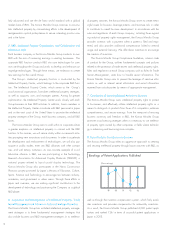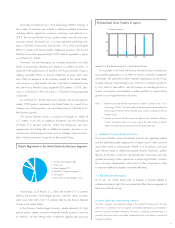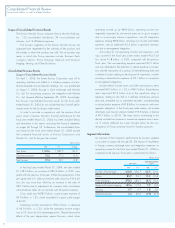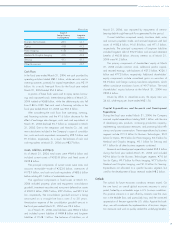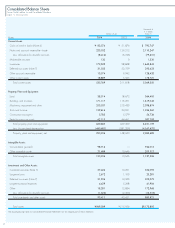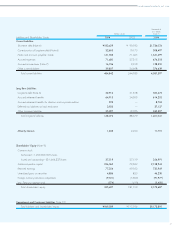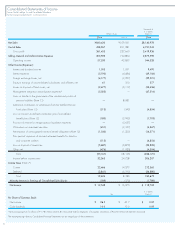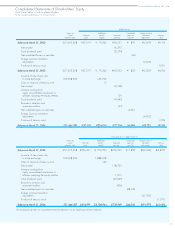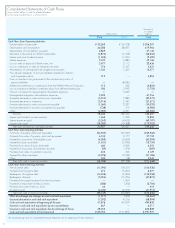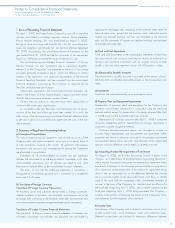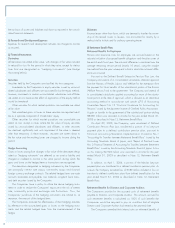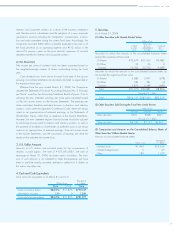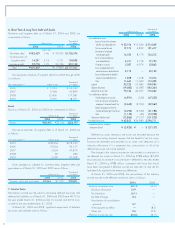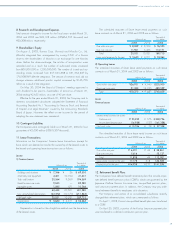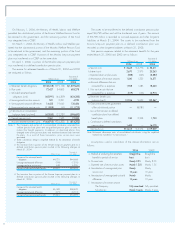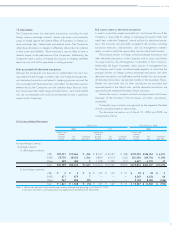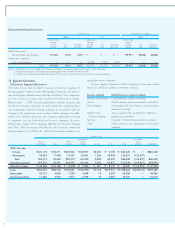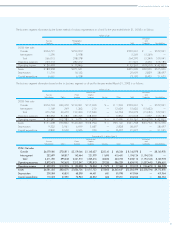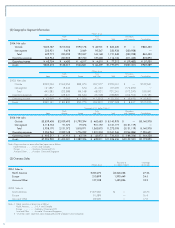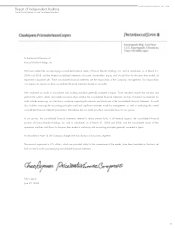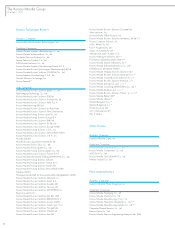Konica Minolta 2004 Annual Report Download - page 48
Download and view the complete annual report
Please find page 48 of the 2004 Konica Minolta annual report below. You can navigate through the pages in the report by either clicking on the pages listed below, or by using the keyword search tool below to find specific information within the annual report.
46
the tax basis of assets and liabilities and those as reported in the consoli-
dated financial statements.
(i) Research and Development Expenses
Expenses for research and development activities are charged to income
as incurred.
(j) Financial Instruments
Derivatives
All derivatives are stated at fair value, with changes in fair value included
in net profit or loss for the period in which they arise, except for deriva-
tives that are designated as “hedging instruments” (see Hedge
Accounting below).
Securities
Securities held by the Companies are classified into two categories:
Investments by the Companies in equity securities issued by unconsol-
idated subsidiaries and affiliates are accounted for by the equity method;
however, investments in certain unconsolidated subsidiaries and affiliates
are stated at cost because the effect of application of the equity method
would be immaterial.
Other securities for which market quotations are available are stated
at fair value.
Net unrealized gains or losses on these securities are reported net-of-
tax as a separate component of shareholders’ equity.
Other securities for which market quotations are unavailable are
stated at cost, except in cases where the fair value of equity securities
issued by unconsolidated subsidiaries and affiliates, or other securities
has declined significantly and such impairment of the value is deemed
other than temporary. In these instances, securities are written down to
the fair value and the resulting losses are charged to income during the
period.
Hedge Accounting
Gains or losses arising from changes in fair value of the derivatives desig-
nated as “hedging instruments” are deferred as an asset or liability and
charged or credited to income in the same period, during which the
gains and losses on the hedged items or transactions are recognized.
The derivatives designated as hedging instruments by the Companies
are principally interest rate swaps, commodity swaps and forward
foreign currency exchange contracts. The related hedged items are trade
accounts receivable and payable, raw materials, long-term bank loans,
and debt securities issued by the Companies.
The Companies have a policy to utilize the above hedging instru-
ments in order to reduce the Companies’ exposure to the risk of interest
rate, commodity price and exchange rate fluctuations. Thus, the
Companies’ purchases of the hedging instruments are limited to, at
maximum, the amounts of the hedged items.
The Companies evaluate the effectiveness of their hedging activities
by reference to the accumulated gains or losses on the hedging instru-
ments and the related hedged items from the commencement of the
hedges.
(k) Leases
Finance leases other than those, which are deemed to transfer the owner-
ship of the leased assets to lessees, are accounted for mainly by a
method similar to that used for ordinary operating leases.
(l) Retirement Benefit Plans
Retirement Benefits for Employees
Pension and severance costs for employees are accrued based on the
actuarial valuation of projected benefit obligations and the plan assets at
the end of each fiscal year. The actuarial difference is amortized over the
average remaining service period (mainly 10 years), using the straight-
line method from the year subsequent to that in which the actuarial differ-
ence was incurred.
Pursuant to the Defined Benefit Enterprise Pension Plan Law, the
Company and several of its consolidated subsidiaries obtained approval
from the Ministry of Health, Labour and Welfare for the exemption from
the payment for future benefits of the substitutional portion of the Konica
Welfare Pension Fund to the government. The Company and several of
its consolidated subsidiaries applied accounting for return of the substitu-
tional portion at the date of approval, which is allowed as an alternative
accounting method in accordance with article 47-2 of Accounting
Committee Report No.13 “Practical Guidance for Accounting for
Pensions” issued by the Japanese Institute of Certified Public Accountants.
A gain on transfer to the government of the substitutional portion totaling
¥8,081 million was recorded in income for the year ended March 31,
2003 as described in Note 12, Retirement Benefit Plans.
On April 30, 2003, the Company, upon enactment of Defined
Contribution Pension Plan Law, transferred a portion of its lump-sum
payment plan to a defined contribution pension plan, pursuant to
Financial Accounting Standards Implementation Guidance No.1
“Accounting for Transfers between Retirement Benefit Plans” issued by the
Accounting Standards Board of Japan, and “Report of Practical Issues
No. 2 Practical Treatment of Accounting for Transfers between Retirement
Benefit Plans” issued by the Accounting Standards Board of Japan. A loss
on this totaling ¥2,993 million was recorded in income for the year
ended March 31, 2003 as described in Note 12, Retirement Benefit
Plans.
In addition, on April 1, 2004, a portion of the Minolta lump-sum
payment plan was transferred to a defined contribution pension plan. As
a result, the Company recorded loss of ¥180 million included in loss on
transition to defined contribution plans from defined benefit plans for the
year ended March 31, 2004 as described in Note 12, Retirement
Benefit Plans.
Retirement Benefits for Directors and Corporate Auditors
The Companies provide for the accrued costs of retirement benefits
payable to Directors and Corporate Auditors. The amounts accrued for
such retirement benefits is calculated as 100% of such benefits the
Companies would be required to pay on condition that all eligible
Directors and Corporate Auditors had retired at the year-end date.
The Companies amended their internal rules on retirement benefits of


